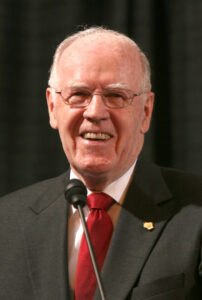Remembering a Marquette Lawyer (and Judge) on the Centennial of His Birth
 A week and a half ago, the Law School held our annual Alumni Awards Reception and Conferral—always a highlight of our year. For it enables us to celebrate Marquette Law School’s spirit and ideals by recognizing four exemplars of the genus (or perhaps it’s the species) of the Marquette lawyer.
A week and a half ago, the Law School held our annual Alumni Awards Reception and Conferral—always a highlight of our year. For it enables us to celebrate Marquette Law School’s spirit and ideals by recognizing four exemplars of the genus (or perhaps it’s the species) of the Marquette lawyer.
I had occasion that day to talk with a longtime colleague about past such alumni awards receptions and conferrals, including the one in 2007, where we honored Martin J. Greenberg, L’71, with the Charles W. Mentkowski Award for the Sports Law Alumnus of the Year; (now-Judge) Katie Maloney Perhach, L’00, with the Howard B. Eisenberg Service Award; the Hon. Patricia J. Gorence, L’77, as the Alumnus/a of the Year; and the Hon. Thomas J. Curran, L’48, with the Lifetime Achievement Award. Then, last week, my colleague noted to me that today would have been the 100th birthday of the last of these individuals (the other three, happily, still being active alumni). I relate a brief story about Judge Curran here.
I recall my commendation of him on that occasion in 2007. I said in part this:
You may think that it is his service for almost a quarter-century as United States District Judge here in Milwaukee that recommends [Tom Curran] for this award. And this is relevant, for it is a lifetime achievement award. I am inclined to think, though, that Tom Curran would be receiving this award even if he had never become Judge Curran, for his accomplishments from 1948 to 1983 would have sufficed.
Tom Curran joined his brothers’ law firm in Mauston, Wisconsin, in 1948, and for a brief moment—a year or so—the firm was Curran, Curran & Curran. That did not last, not I am sure because of any difficulty on the part of Irish brothers in getting along with one another, but because one of his brothers left in 1950 to become a circuit judge in Juneau County, where he served for the next 30 years. The firm flourished nonetheless, and today it is one of the largest firms in the state outside of a major metropolitan area (with apologies to the many Currans and others here today from Mauston for my characterization).
Of course, the fact that there are several Currans at the firm still (Judge Curran’s children) does contribute to the numbers somewhat, but you cannot maintain a firm of this size—or even stay in business for so long—without developing a reputation for quality and trustworthiness, and the Curran firm surely has that reputation. And much of that reputation developed during Tom Curran’s 35 years of practice in Mauston.
His own stature as a lawyer meant that Tom Curran was elected by his statewide peers to the presidency of the State Bar of Wisconsin, a signal honor.
I said more, but let me move the story along. I also recall a portion of Judge Curran’s remarks in then accepting the Lifetime Achievement Award:
Given the very special place Marquette already had in the lives of the Currans, it was no surprise, when I was discharged from the Navy in July 1946, that I would come up and enroll at Marquette. And I found myself, four days later, sitting in a classroom, as we then had the three-semester-a-year program, given that probably 95 percent of us were veterans. I would guess that we ranged in rank from a private to a brigadier general—a former brigadier general. The only problem was that the general had trouble remembering the “former” part of it—or at least he did, for maybe two or three weeks, until he ended up in Professor Ghiardi’s class.
Finally, I recall but, alas, cannot directly quote the moment in his acceptance remarks—not scripted, I should think—where Judge Curran turned around from the podium and looked back at Rev. Robert A. Wild, S.J., then the president of Marquette University, and me.
Judge Curran noted the coincidence of two guys from the South Side of Chicago leading a beloved Wisconsin institution, and his remarks were most generous. This was characteristic of Judge Curran, in my experience: he made that moment not about himself but about others—and about Marquette.
I have never forgotten it or him. It is pleasant to remember a generous and gracious Marquette lawyer and judge both on his 100th birthday and on other occasions.

 Next week, the Supreme Court will hear oral argument in
Next week, the Supreme Court will hear oral argument in 